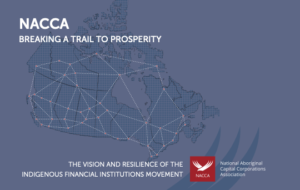-
Aboriginal Financial Institutions (AFIs) are formed at the recommendation of First Nations leaders, initially believing the $25 million tranche would make it a short term project.
-
6 initial AFIs, with a 7th in 1995, started a voluntary network. The initial six were:
- Alberta Indian Investment Corporation.
- Indian Agricultural Business Corporation.
(now Indian Business Corporation) - Saskatchewan Indian Equity Foundation.
- Société de Crédit Commercial Autochtone.
- Tale'Awtxw Aboriginal Capital Corporation.
- Ulnooweg Development Group.
-
NACCA is incorporated through the formal Association act, now representing 22 ACCs.
-
1998-1999 INAC Deputy Minister’s Outstanding Achievement Award received for the development of Access to Capital programing (forerunner of AEP)
1998 Launch of the First Nations and Inuit Youth Business Program brings together the network through its Board of Directors.
1999 Membership open to all AFIs across the country. NACCA partners with Industry Canada and Peace Hills Trust to deliver the Aboriginal Entrepreneurship Program (AEP).
-
Membership surpasses 50 AFIs.
-
- INAC takes over AEP program from Industry Canada
- Funding is in the $7M range AFIs provided 30,520 loans accumulating.
- $1,227,705,748, recording a 100% GLP increase in a ten-year period.
-
First time in AFI history to provide $100 million in loans in a single year.
-
Succesfully complete program renovation negotiations with INAC.
-
- $2 billion milestone in developmental loans to Aboriginal entrepreneurs and businesses.
- The Aboriginal Developmental Loan Allocation (ADLA) program is added to the AEP.
- Funding increases to $10M.
-
The NACCA assumes manager responsibilities and administration of funding agreements with AFIs for the Aboriginal Business Financing Program (ABFP).
History
IFIs were created in the late 1980s and early 1990s by Indigenous leaders, the Government of Canada, and a Native Economic Development Program initiative to address the lack of available capital to finance Indigenous small-business development. IFIs are also supported by regional development agencies (RDAs).
IFIs were created to provide repayable, interest-bearing loans to Indigenous small- and medium-sized enterprises (SMEs) that were unable to secure loans from highly-regulated conventional lenders due to risk tolerance levels.
Several IFIs joined together to form NACCA and retain their autonomy. The purpose of NACCA was to increase the number of Indigenous entrepreneurs in Canada and provide opportunities for Indigenous entrepreneurs to be successful.
NACCA was developed as a trade association to provide support for IFIs; to provide best practices for lending to Indigenous people; to advocate to government and potential funders; and to promote the IFI network.
Today, NACCA is a network of over 50 IFIs that supply developmental lending directly to Indigenous entrepreneurs and communities. In turn, this provides a return on investment rate to GDP. NACCA continues to seek additional sources of capital to ensure the network remains sustainable.

